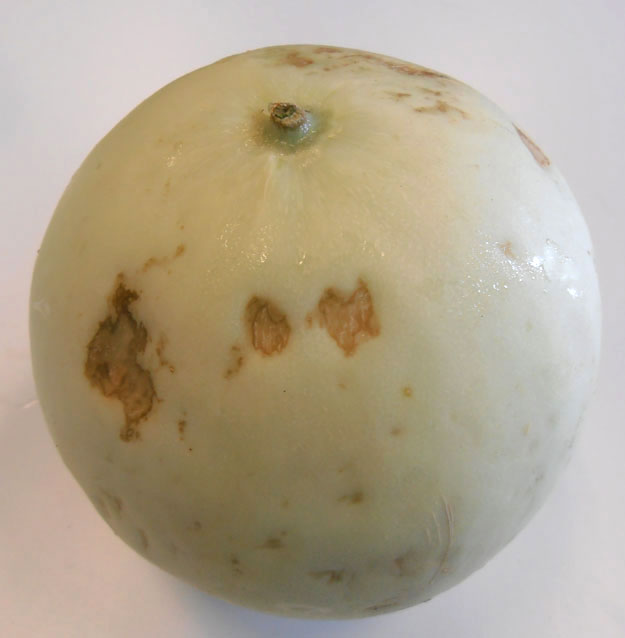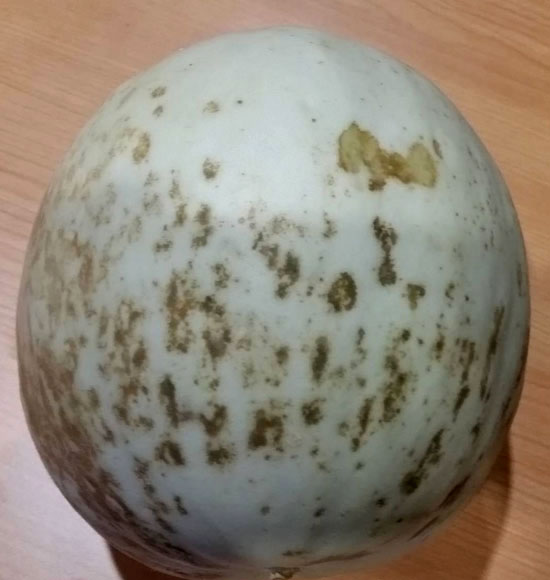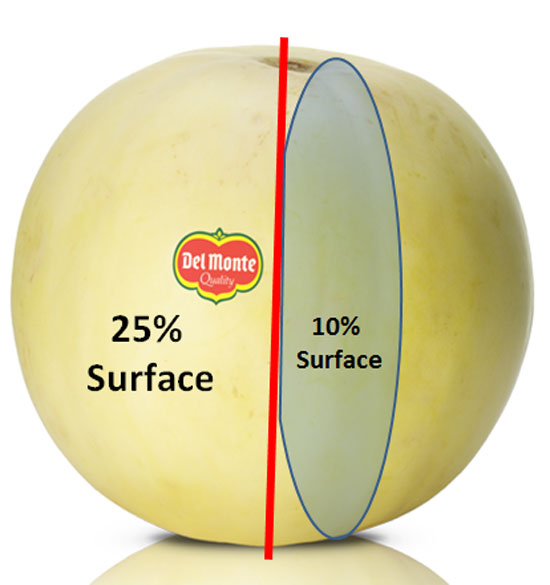We have all seen the defect, “sunken discolored areas” on honeydews before. Of all the defects seen on honeydews this is one of the most commonly found.

Sunken discolored areas occur due to various factors, but bruising or rough handling is the major culprit. Somewhere along the harvesting, packing to transportation process the honeydew was subjected to some rough handling that resulted in the outside rind to bruise. The bruising was severe enough to damage the cell walls of the epidermis leading to the surface of the rind to sink and discolor.
From a paper written by Marita Cantwell on the quality assurance of melons, she found, “Water loss from scuffed areas is a major is a major cause for water loss in cantaloups. This leads to sunken discolored areas on the fruit surface and is often seen on melons in retail displays. Water loss is a cumulative process and the warmer the temperature, the greater the water loss. Low temperature and high humidity are required to maintain the cantaloup firm during handling.”
But the question we have, as inspectors, when are the sunken discolored areas numerous enough to be scored as a defect against the U.S. No. 1 Grade? The USDA Inspection Instructions on Honeydews fails to address this defect specifically. They do state, “The dark discoloration sometimes seen on honeydew melons shall be scored on the basis of appearance. The degree of darkness of the discoloration influences the portion of the melons’ surface that should be affected before it is scored as being damaged. Care should be taken not to confuse the yellowish areas, which are characteristic for honeydew melons, with discoloration.
Scoring Guide
Score as damage when 20% of the melons’ surface has a light brown discoloration or 10% of the surface has a dark brown discoloration. Score as serious damage when seriously affecting the appearance of the melon.”
That will give us a starting point. The above defect the USDA is talking about is surface discoloration, not sunken discolored surface discoloration, which is always scored more severely.
First you must be able to determine the proper percent of surface area of a honeydew. Looking at the image above, you can see that 50% of the melon is divided in half with a red line, showing you 25% of the surface. The 25% area on the right side is shaded to illustrate approximately 10% of the honeydew’s surface. Now looking at the first image, shown above, the dark brown sunken discolored area does not appear to aggregate a surface area of more than 10% of the surface. But because the discolored area is sunken, you would be allowed less an area than that allowed for strictly a dark brown discolored spot, with no depth. How much less? Use your judgement, but you can use 5 to 1o% of the surface area as a guide, depending on the darkness of the discoloration and the depth of the defect. The darker the discoloration, and the more depth noted, the smaller the area allowed. The melon shown in the top image would be scored as “damage by sunken discolored areas.”

Do not take this condition defect lightly, as this honeydew quickly developed “serious damage by sunken discolored spots” in a manner of 3-4 days, (still in the warehouse) after being received showing no signs of this defect.


No Comments on “Honeydews- Sunken Discolored Areas”